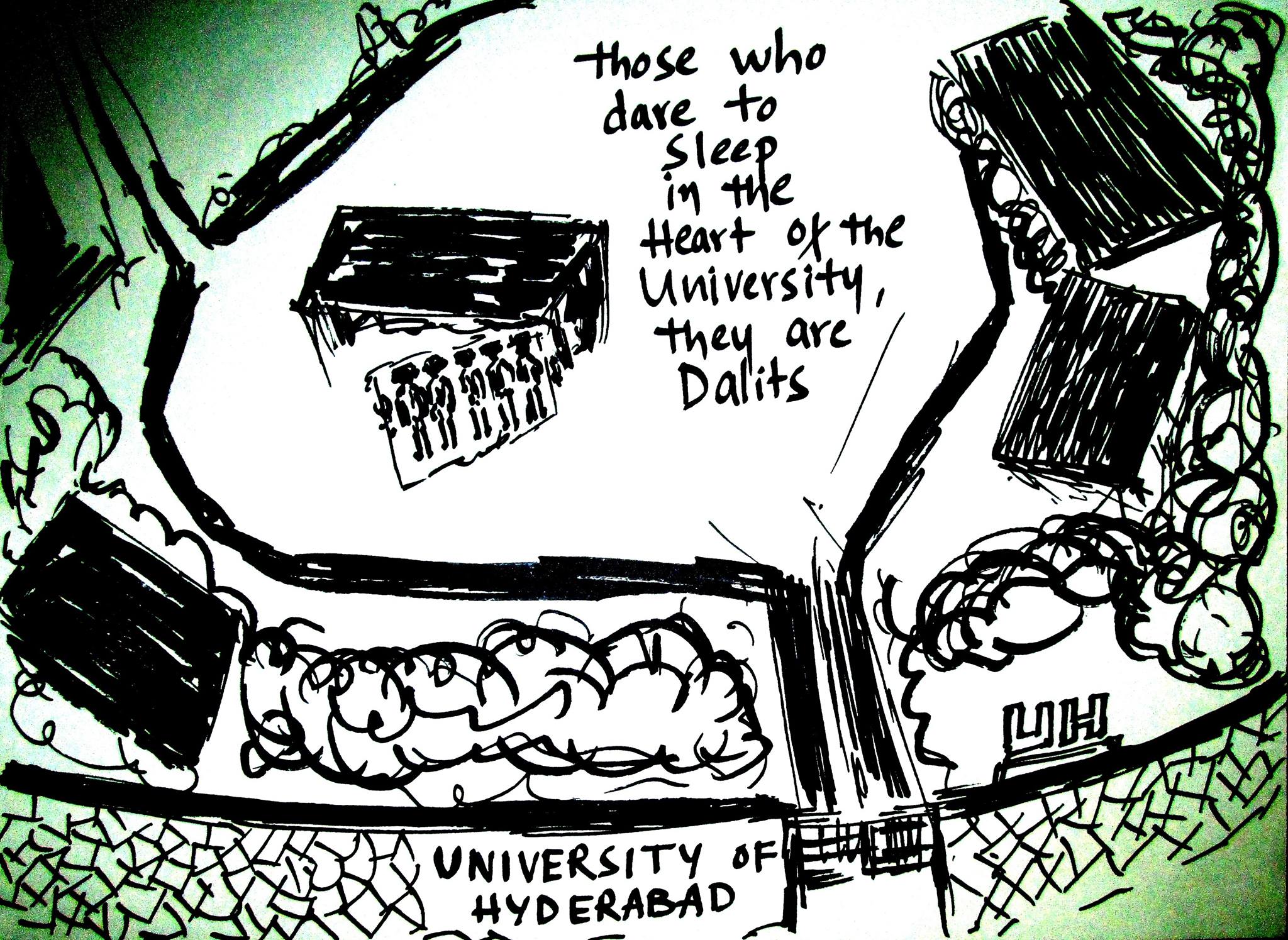S Kumar
Rohith Chakravarti Vemula (30 January 1989 – 18 January 2016) was a PhD student at the Central University of Hyderabad and his suicide on 18 Jan 2016 sparked an outrage throughout India, highlighting the cases of systemic discrimination in educational campuses across India. Many cases of caste atrocities have been reported recently. One of them was that of a Dalit man killed in Ahmednagar in 2015 for keeping a mobile ringtone that had Ambedkar’s praise. In another case, Dalit children were burnt alive in Faridabad, which a cabinet minister VK Singh compared with the death of dogs.

Similar to the protest in the case of Rohith Vemula, protests across Maharashtra took place in 2006 against the brutal killing and raping of a Dalit family in Khairlanji, Dist. Bhandara in Maharastra. The cases of Dalit atrocities are not very unusual in independent India. However, a nation-wide outrage and protest are reported in few cases only, particularly due to media apathy and systemic suppression of Dalits’ Voice by the upper castes.
Further, there have been many cases of caste related violence which caused large resentment in Dalit communities against the Govt. Some of these cases include violence in Dharmapuri (Tamil Nadu) in Dec’12, killing of Dalits in Ramabai Colony (Maharashtra) in Jul’1997, killing of 6 Dalits in Melavalavu (Tamil Nadu) in Jun 1997, killing of 8 dalits in Tsunduru (Andhra Pradesh) in August’ 1991 and the Dalit massacre in Karamchedu (Andhra Pradesh) in July’1985. Further, a series of massacres took place in Bihar in 1990s by Ranvir Sena (a Bhumiyar caste group) which included killing of 21 Dalits on 11 July 1996 in Bhatani Tola (Bhojpur, Bihar) and killing of 58 Dalits in Dec 1997 in Laxmanpur Bathe (Bihar).
Provision of safeguards for the marginalized
Historically, in pre-independence India, Dalits have faced brutal atrocities too. However, Independent India was created with an idea of representation in the governance for all the segments of society and to secure Justice, Liberty, Equality and Fraternity for all citizens. Further, the architects of independent India, most notably Dr. B.R. Ambedkar, were aware of the shortcomings of independent India without any British presence.
On Friday, the 25th November 1949, a day before the Parliament adopted the Constitution of India, Dr B.R. Ambedkar himself admitted that he came to the Constituent Assembly to safeguard the interests of Scheduled Castes. He said, “I came into the Constituent Assembly with no greater aspiration than to safeguard the interests of the Scheduled Castes.”
Among many provisions provided to safeguard the interest of SCs and STs, some are as follows:
The Constitution of India contains fundamental rights with Principles of equality; prohibition of discrimination on the grounds of caste, religion, sex, creed, place of birth; and abolishing untouchability with punishment by law. Further, the Constitution allows the state to make special provisions for providing positive discrimination to backward classes and also for the Scheduled Castes and Scheduled Tribes. Moreover, the aspirations which could not be fulfilled immediately by the state, were included in Directive Principles of State Policy. This included the aim to promote the educational and economic interests of the Scheduled Castes and Scheduled Tribes and other weaker sections. Further, Constitutional remedy was provided to the citizens to move the Supreme Court for enforcement of fundamental rights. Additionally, the constitution also provided for reservation for Scheduled Castes and Scheduled Tribes in Lok Sabha and State Legislatures.
There are three official wings of Indian democracy i.e. the Executive, Legislature and Judiciary, which are called pillars of democracy; media being the fourth pillar without any official sanction. So, let’s assess how the safeguards, planned earlier under the three pillars of democracy, have worked in case of Dalit atrocities, to avoid further occurrences. The executive is not directly elected, as it is elected by the majority of Lok Sabha members. Further, it has no mandatory SC/ST reservation. However, the decision making process is supposed to be democratic among Lok Sabha members with a consensus decision making process. Also, the executive is not sovereign, as all the decisions are expected to be scrutinised by the Parliament and further it is subject to judicial review. Additionally, as per the constitution, the executive with Council of Ministers shall be collectively responsible to the House of the People i.e. Lok Sabha.
Regarding Judiciary, it is the custodian of the Indian Constitution and it is the heart and soul of the constitution with all legal remedies. However, it does not have any mandatory reservation for SC/ST and their decision-making process is not democratic, but guided by law. The trust on Indian Judiciary is very little for SC/STs because it has consistently failed to protect the fundamental rights of citizens and it has worked with very little SC/ST representation. Further, a Judge of Supreme Court can be removed by order of the President passed by two third majority in Parliament, which can regulate the procedure for investigation and proof of misbehaviour or incapacity of a Judge.
The third pillar is Legislature i.e. Parliament that has mandatory representation of SC/STs in proportion to their population in Lok Sabha only and the members of Lok Sabha are directly elected by the citizens of India. The SC/ST reservation was initially envisioned for a period of 10 years and it can be abolished only with the support of SC/STs. It has been extended after every 10 years since then. Rajya Sabha is indirectly elected and it has no SC/ST reservation. Parliament is an institution with democratic decision-making process and it is sovereign, not absolute but subject to only judicial (which has little SC/ST representation) review.
So, for the SC/ST population, who are the worst sufferers of injustice from the upper caste in India, where can they look for constitutional remedy as envisaged by Dr. BR Ambedkar? The cases which are mentioned above, at the beginning of this article, have been for a long time, since brahminism has its sway over India. However, Babasaheb envisaged some remedies through constitutional means, as he never propagated the idea of revenge through violence.
The first place any victim of any caste injustice reaches out to is the executive. All the power of the Government is vested in the executive branch. Hence, victims of caste atrocities often reach out to the executive to get some support for Justice in the form of strict enforcement of law. However, executive has no reasons to act on any atrocity unless there is any fear of any disincentive in case of irresponsible behaviour. The executive is directly elected by the members of the Lok Sabha with the Prime Minister, heading the council of ministers, and it needs to prove the majority on the floor of the house.
However, there is no mandatory reservation of SC/ST in the executive branch of the government. The executive branch is not directly accountable to the citizens, as they are not directly elected, but they are indirectly accountable through Parliament. Executive, like any kingdom or autocracy, wants to enjoy the power till there is no threat to losing the power. Hence, to make the Government act on caste violence and make them accountable, the victim and people seeking justice try to reach out to the Parliament by approaching its elected members.
Next, let’s take the case of the Judiciary, which is powerful but with very limited accountability. The Indian Judiciary has consistently failed to protect Human Rights as granted by the Constitution under the Fundamental rights. Further, Judiciary has no reservation for SC/ST and hence expectation of sensitivity, in the matter of atrocities, from Judiciary is unreasonable. This is especially true because the perpetrator of caste violence and Judges in the court, making the decision, often belong to the same upper castes. How can SC/STs trust the Judiciary, because the result has been no different from the earlier period of pre Independence India?
Let’s take the last constitutional alternative i.e. Legislature or Parliament, left for the SC/ST victims of caste injustice. Parliament, being the sovereign (only bounded by Judicial review), has the maximum power. Further, the share of representation for SC/STs in Lok Sabha is at par with their population. Moreover, it has the power to take Executive and Judiciary on task for any wrong doing. Hence, the victims of caste injustice have highest expectation and maximum reach to the representative of their demographic constituency and/or to their community (SC/ST) representative.
The demographic constituency representative, where the victim is the voter, is directly accountable to any wrongdoing in his/her constituency and it’s the duty of the representative to do whatever possible constitutionally to protect the interest of the constituency and its people. Moreover, the elected representative has to go back to the constituency for re-election after every 5 years. Additionally, the elected representatives from other constituencies also need to be re-elected after every 5 years from their respective constituencies. Hence, the other representatives must also satisfy the demands of various communities including SC/STs to get their support in the election.
The reservation for SC/STs provided in the Parliament by the Constitution ensures fair representation of the marginalised community. The clause that political reservation for SC/ST needs to be reviewed after every 10 years can be separately analysed. Given that political reservation continues till date, it is expected that the issue of caste discrimination (especially human massacres) must be raised in the Parliament by the people coming from similar social background i.e. SC/ST. Further, SC/ST representative must come together to bring accountability of the executive. Why are the governments not pulled down by withdrawing the support by the SC/ST representatives?
Where is the Government accountability?
The question that arises is: why after so many caste atrocities, the Government is not held accountable for its action or inaction to stop such atrocious incidences? Why the democratically elected Parliament members don’t bring down the Government of India for various events of caste injustice?
Voices have been raised that what is the use of SC/ST representative elected as MP/MLA, if they are unable to raise their voice in the Parliament to highlight caste atrocity issues and make the government accountable. Many activists have gone up to the extent of demanding removal of reservation for SC/ST in the Parliament. But the author would like to argue that the same argument should be given to finish the representation on any (general) elected official as they have equally, or more so, failed to raise the caste atrocity issues in their own constituency or any other constituency (as other constituencies also have SC/ST people from the victim community). Why the elected representative SC/ST/others are failing to do their duties? Why are they unable to hold the Government accountable? There are many ways provided in the Lok Sabha procedures to hold the Executive accountable.
What can the elected SC/ST ministers, who are expected to be more sensitive to caste atrocities, do in case of caste atrocities? Yes, they can raise these questions in the parliament, but the Government in power can answer whatever way they want till there are no repercussions. Like the BJP ministers usually do, saying that so many cases happened during 50 years of Congress rule. If it is a Congress led Government, they usually reply that we are taking all necessary steps to resolve the situation, without doing absolutely anything. What do the BJP or Congress government do in case of excess pressure from public? They both create an enquiry committee of judges or senior retired officials, which takes decades to complete the report and even if it gets completed, it does get to see the light of day in Parliament. Further, whatever the final report says, after multiple extensions in timelines, it does not get implemented. That’s the usual modus operandi of various Governments to save their position in power, without acting against the powerful upper castes. Where is the Government accountability?
The most important tool provided to any elected representative is to bring a no-confidence motion, without giving any reasons, against the Government. Any elected Lok Sabha member can bring a no-confidence motion in the Lok Sabha, and it needs to be supported by 50 MPs, then every member can participate in the discussion within the Parliament followed by voting on the motion. Once a majority of the members vote against the Government, the Council of Minister must resign. No-confidence motion can only be brought in the house 6 months after any previous confidence or no-confidence motion.
This allows regular assessment of the Government as envisaged by the architects of Constitution in independent India, where Government will protect the rights of citizens. Thus, the government is always under fear of losing power i.e. confidence of Parliament and act immediately against caste atrocity cases without waiting for another 5 years for the next election.
As Dr. B.R. Ambedkar said on 4 Nov 1948 in the Constituent Assembly during the discussion on the Constitution drafting “The Daily assessment of responsibility which is not available under the American system it is felt far more effective than the periodic assessment and far more necessary in a country like India.”
Now, why are the elected MPs from SC/ST/others unable to bring confidence against the Government in caste atrocity cases? It comes out that no-confidence motion has almost no meaning left in the Indian Parliamentary system. Let us look at the data for no-confidence motion since the first Lok Sabha.
Since, the first Lok Sabha election in 1952 till 2015, a total of 26 no-confidence motions have been brought in the Parliament against the Government. From 1952 to 1984, a period of 32 years, a total of 21 no confidence were brought in the Lok Sabha with a record 15 no-confidence motions against the Indira Gandhi Government. From 1985 to 2015, a period of 33 years, only 5 no-confidence motions were brought in the Parliament.
Among the 26 no-confidence motions, all others were decisively defeated except in 1979 when Morarji Desai resigned after an inconclusive debate. Many of the Governments fell in 1990s, due to lack of support in the confidence motion (different from no-confidence motion). Although, some no-confidence notices were bought during 2012 to 2014, it could not gather sufficient support of 50 MPs to put on vote as no-confidence motion.
The anti-defection law curtailing freedoms
So, why has the number of no-confidence motions reduced after 1985, even though the electoral mandate is much more fractured after 1985? The answer lies in the 52nd constitutional amendment better known as Anti-Defection Law or Dal badal kanoon, which added a tenth schedule in the constitution, which was passed in 1984. It enables disqualification of legislators on grounds of defection in case an MP either voluntarily resigned from his party or disobeyed the directives, in the form of whip issued by the party, on a vote. The decision of defection and disqualification shall be decided by the speaker of House.
This whip issuance, under the anti-defection law, needs profound probing in terms of freedom of expression and liberty of the elected MP. The rights of MPs in the Parliament have been given special safeguards, as none of the Courts including the Supreme Court can interfere on any statement or vote within the Parliament. How can an elected MP, regardless of party or community (SC/ST) which the member belongs to, exercise the freedom of expression in the Parliament under the anti-defection law? Can anyone bring a notice of no-confidence motion against the government and will any MP support no-confidence motion with their own wisdom, with the threat of losing their seat in the house under anti-defection law? What is the use of SC/ST reservation in the Lok Sabha, when they are not allowed to exercise their voting rights inside the Parliament? How can they represent and fight for the interests of SC/ST if they only have to follow the party mandate?
The anti-defection law negates the proportionate reservation of SC/STs in Lok Sabha, as the elected SC/ST members can not decide their own votes (against the party whip). So, the separation between Parliament and Executive, created by the original constitution, are fused by providing the authoritative power to the Political party which issues the whip. Now the elected MP and executive are only accountable to the Political party, because only the defiance to party whip can make them lose their positions. So, there is no accountability of the Executive towards the Parliament and it is only limited to verbal rhetoric, without any fear of losing their position till the party(ies) support them. The accountability is deferred to next election after 5 years. There is no space for individual freedom to vote with own individual wisdom for the elected MPs.
During the discussion in Constituent Assembly on 4th Nov 1948, the Chairman of Drafting Committee Dr. B.R. Ambedkar elaborated on the question as to which form of government i.e. Parliamentary or Presidential form Indian Constitution will provide. He said:
“Both systems of Government are of course democratic and the choice between the two is not very easy. A democratic executive must satisfy two conditions – (1) It must be a stable executive and (2) it must be a responsible executive. Unfortunately it has not been possible so far to devise a system which can ensure both in equal degree. You can have a system which can give you more stability but less responsibility or you can have a system which gives you more responsibility but less stability. The American and the Swiss systems give more stability but less responsibility. The British system on the other hand gives you more responsibility but less stability. The reason for this is obvious. The American Executive is a non-Parliamentary Executive which means that it is not dependent for its existence upon a majority in the Congress, while the British system is a Parliamentary Executive which means that it is not dependent for its existence up on a majority in the Congress, while the British system is a Parliamentary Executive which means that it is dependent upon a majority in Parliament. Being a non-Parliamentary Executive, the Congress of the United States cannot dismiss the Executive. A Parliamentary Government must resign the moment it loses the confidence of a majority of the members of Parliament. Looking at it from the point of view of responsibility, a non-Parliamentary Executive being independent of Parliament tends to be less responsible to the Legislature, while a Parliamentary Executive being more dependent upon a majority in Parliament become more responsible. The Parliamentary system differs from a non-Parliamentary system in as much as the former is more responsible than the latter but they also differ as to the time and agency for assessment of their responsibility. Under the non-Parliamentary system, such as the one that exists in the U.S.A., the assessment of the responsibility of the Executive is periodic. It takes place once in two years. It is done by the Electorate. In England, where the Parliamentary system prevails, the assessment of responsibility of the Executive is both daily and periodic. The daily assessment is done by members of Parliament, through questions, Resolutions, No-confidence motions, Adjournment motions and Debates on Addresses. Periodic assessment is done by the Electorate at the time of the election which may take place every five years or earlier. The Daily assessment of responsibility which is not available under the American system it is felt far more effective than the periodic assessment and far more necessary in a country like India. The Draft Constitution in recommending the Parliamentary system of Executive has preferred more responsibility to more stability.”
So, the very purpose of the Parliamentary form of Government is negated by the anti-defection rule, as there is no accountability of Executive towards the Parliament on a daily basis. It directly implies that the citizens of India are electing an autocratic form of Government. This provision was inserted with the ulterior motives by the Rajiv Gandhi govt., because the depressed classes were asserting their rights in the post independence era.
After the first Lok Sabha, from 1951 to 1984, there were 21 No-confidence motion brought by the elected MPs, to make the Government accountable to the Parliament. The upper caste media called it a mode of corruption, however the question of corruption is not dealt by restricting the fundamentals of democracy. Corruption is a crime, which needs to be dealt by the Police and Judiciary by punishing the culprits, and it must not be given as reason to suppress democracy itself. If corruption is the bigger issue than democracy, then there should be an autocratic rule because the election process also involves money power.
Hence, if the people including SC/STs want Justice in Rohith Vemula suicide case, and many other cases of caste atrocities, by holding the respective Minister and if required Council of Ministers accountable, it is only possible by free and fair voting inside the Parliament to test the confidence in the Government of the day without the anti-defection law.
~~~
S Kumar is an Engineering and Management graduate from top institutes..
Illustration by Unnamati Syama Sundar.










